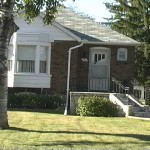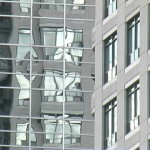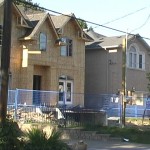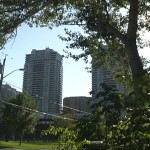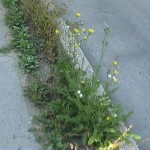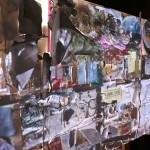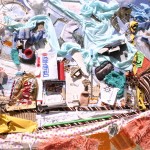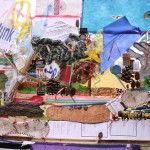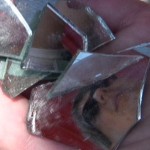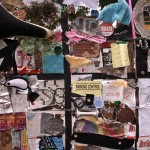Land|Slide: Possible Futures
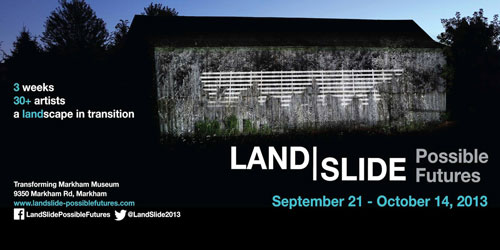
Massive Public Art Exhibition in Markham, Ontario, September 21 – October 14, 2013
"LINES ARE BIOPHYSICAL, EXPERIENTIAL AND CONCEPTUAL DIVISIONS, JUNCTURES AND CONNECTIONS TIED TO THE HISTORY OF LAND"
LAND|SLIDE: Possible Futures is a large site specific Art Exhibition in 2013 in Markham, Ontario, one of the oldest, most culturally diverse and fastest growing suburbs in North America. The line is a critical formal element of the exhibition. In 2010, a proposal for a food belt in the Markham area, a line designed to curtail development into Ontario’s prime agricultural lands was narrowly defeated.
LAND|SLIDE: Possible Futures is a multisectoral project that invites 20 artists—local and international, emerging and established—who work in a variety of media, and whose practice has been engaged with ecological issues to develop different interpretations of the concept of the line.
For more information:
http://www.landslide-possiblefutures.com/
http://twitter.com/LandSlide2013
http://www.facebook.com/LandSlidePossibleFutures
http://vimeo.com/landslide2013
http://mixedbagmag.com/tag/lisa-myers/
http://www.blogto.com/arts/2013/10/its_worth_the_trip_to_markham_for_vast_public_art_exhibit/
http://frankhavermans.wordpress.com/2013/09/20/landslide-markham-toronto/
http://centralcounties.ca/old-world-meets-nouveau-art-landslide-markham/
http://canadianart.ca/must-sees/2013/10/01/landslide-possible-futures/
The Leona Drive Project
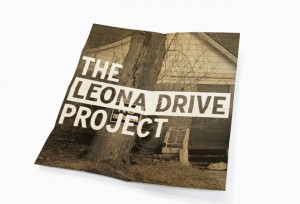
http://leonadrive.info.yorku.ca/
The Public Access Collective will collaborate with L.O.T. : Experiments in Urban Research (Collective) to commission several artist projects for a site specific exhibition in a series of six vacant bungalows slated for demolition by HYATT HOMES, a developer in Willowdale, Ontario (in the Yonge and Finch area of Greater Toronto). The exhibition artists will be working in a variety of media: audio, cell phones with GPS, architectural installation, projection, photography, sculpture and performance for a period of two weeks, from Oct 22 - 31, 2009. Collective members Janine Marchessault (Public Access and LOT) and Michael Prokopow (L.O.T.) will work collaboratively with the artists to develop an exhibition specifically designed to engage with the architecture and spatial design of the houses typical modernist dwellings of the prosperous and decidedly homogenous decades of post World War II Canada and the large backyards.
While the curators anticipate several sub-themes emerging from the individual artists, the overall problematic for the exhibition is the remarkable shift from the suburbs of old to the suburbs of contemporary Canada, namely the neighborhoods and precincts of the multicultural, but nonetheless parsed state. As such, the project will interrogate what has been lost in terms of the older identities and utopias, domestic, regional and national, and the concomitant transformations around issues of gender, race, class and what was broadly proclaimed as the good life. Accordingly, the project will investigate recent developments in suburbia where new patterns of community and conscience operate. Interested in the new ecologies of place, citizenship, transposed tradition, lifestyle and home, Public Access and L.O.T. are concerned with the role of technology and the built environment (from sewage systems to cars) in the quotidian in everyday life (both public and private) of the citizen. The exhibition will host a symposium on the culture of suburbs that will include urban planners, artists and architects.
For more information:
http://www.nowtoronto.com/daily/story.cfm?content=171905
http://urbantoronto.ca/forum/showthread.php/10412-Leona-Drive-Project-(North-York)
http://www.brokencitylab.org/notes/janine-marchessault-the-leona-drive-project/
Willowdale Project

Many representations of urban life harbour a nineteenth century cliché of the centralized metropolis, obfuscating the fact that suburbs are an intrinsic part of North American cities. In much of the literature on the culture of cities (from Jane Jacobs to Richard Florida), the experience of suburban spaces is generally left out of any discussion of urban culture. Urban and place based cultural researchers need a new vocabulary to describe the complex and differientiated spaces we call suburbs since more than 40% of Canadians live in suburban places. Given the gaps, omissions and assumptions about suburban culture in work on the culture of cities, "Exploring the Culture of Suburbs," is an initial foray into new methodologies and research questions for studying these metropolitan spaces. The proposed study will redirect urban cultural theory to consider new objects and places of study alongside new methodologies to take into account the contributions that suburban communities make to the economic and cultural significance of cities.
The project begins with the assumption that suburbs are not unified and uniform spaces. Rather in Canada, they are complex places that are among other things the product of organic growth (extensions of central cities) as well as economic development. For this reason, a case study approach is being proposed as the most beneficial way to develop a grounded and detailed analysis. The suburb of Willowdale in North York near York University, has been selected for the focus of the study as it is one of Toronto's oldest inner suburbs and is known for both its cultural diversity (59% of the residents are immigrants) and its spatial complexity being annexed to Highway 401 and being the last stop on the Finch subway from downtown. Willowdale also houses a variety of cultural architectures and spaces: a civic square, a performing arts centre, a library, two art schools, a community garden, several galleries and community centres. The methodological framework that the study will seek to develop, derives from the Toronto School of Communication (Marchessault 2005) and relies on the notion of 'cultural ecology'—that is, culture as an environment that is dynamic and shaped by the interaction of the non-human (built and natural environments, urban design, objects, histories and technologies) with human actions. This approach to place takes into account the historical and phenomenological complexity of built spaces and will utilize a variety of audio-visual and new media technologies to carry out the studies of individual and interconnected places, daily rhythms, forms of social interaction and patterns of movement across space, cultural events and objects, as well as interviews with appropriate stakeholders, community groups, and cultural policy makers. It is hoped that this research will lay the foundation for the initiation of a larger comparative study of the cultures of suburbs in Canada, recognizing the specificities of these spaces, to increase our understanding of metropolitan cultures in Canada.
Indigenous Oral History Sound Project
Julie Nagam (2008)
The purpose of this sound piece is to tell a story through an Indigenous perspective about a site-specific area of land surrounding the Humber River Valley in what is now known as Toronto, Canada. Searching the land for an Indigenous history in a city that perpetually transforms is a daunting and difficult task. To further compound the growing cityscape, the Indigenous history of the land is situated in many conflicting stories from historians, archeologists, Indigenous nations and competing ethnic groups. All of these associations want to lay a claim to the area and link their knowledge to the territory. As well, there are numerous groups of people who seek to create an exciting, exotic and romantic history in order to satisfy tourism and promote interest in the City of Toronto. Within this complicated mix, how does a person begin to push aside bloated egos, distorted ‘facts’ and competing knowledges for the area? First, (re)membering that history is a version of stories that are approached from different perspectives, knowledges and worldviews and second, digging up as much information and artifacts as possible to begin to connect the stories in a circular discourse as opposed to a linear time frame.
Therefore the project is a creative intervention, which challenges a linear 'factual' western account of the history of the area. The sound piece is a collection of voices and the knowledge of historians, archeologists, elders, various texts, landscape, maps and archival documents and testimonies. The sound piece is a walking tour that takes a person through the area, which tries to create re-remembered knowledges, re-imagined spaces and re-situates the importance of the land. You will be able to download a map and MP3 to take you through the space. It begins in the west end of Toronto at Jane St and Annette St and takes you through part of Baby Point, Tree Sanctuary, Etienne Brule Park and back to the Jane or Old Mill subway stop.
People to thank for making the project possible: Anna Friz (sound artist and technical support), Toronto Tree Tours, Liz Forberg, David Redwolf, Madeleine McDowell, Ron Williamson, Archeological Services, Eva Nesselroth-Woyzbun, Kate Wells, Future Cinema Lab, Janine Marchessault, Toronto Historical Society, Woodlands Cultural Centre, Carl Benn, Parks Canada.
Short Horizon
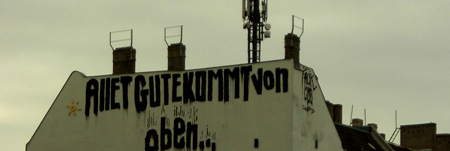
Anna Friz (2008)
Short Horizon is an ongoing research project by LOT member Anna Friz that seeks to balance documentary, imagination, and reverie: specifically working with binaural acoustic field recordings and recordings of sounds transduced from VLF (Very Low Frequency) antennas in order to create deeply textured compositions. This practice of urban field(s) recording broadly proposes transmission as an environmental state or landscape in and of itself. Of particular interest is the relative flatness and depth perceivable in both acoustic and Hertzian space, and the diminishing horizon in the contemporary city as a result of urban design and an exponential increase in wireless infrastructure (or EM clutter). Methodologically, urban field(s) recording will also form the basis of other sonically-focussed projects proposed by Friz together with LOT colleague Jason Rovito. Short Horizon consists of a series of compositions based on recordings made mainly in Toronto. Sites of interest include the Emerson exit of the Lansdowne subway station, Sterling Road, the corner of Montrose and College streets, and domestic radiation around my house. Each of these sites has been chosen for their unique acoustic and EM character--whistling doors, harmonic drones from air circulation systems, proximity to airport flight path, Good Friday march by Italian Catholics, defunct satellite dishes, significant clusters of cell towers and base stations, or flickering neon signs.
Short Horizon has been presented as a four-part serial (consisting of 4 60-minute compositions for radio) at the Banff Centre for the Arts, Walter Phillips Gallery and Radio Free Banff, as part of the exhibition "Bureau de change" in August-September 2008.
Short Horizon will be released as a CD dispatch, co-produced with free103point9.org Transmission Arts Centre in winter 2009.
Collect My Junk
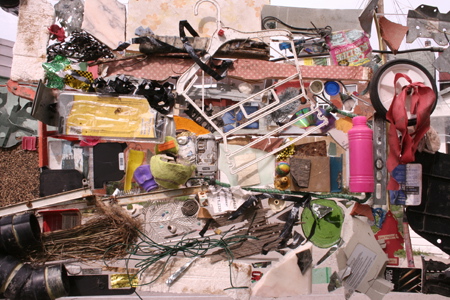
Angela Joosse, Aleksandra Kaminska, Shana MacDonald (2007)
Collect My Junk is a video sculpture presented over three garage spaces. This project examines the discarded objects that make up the city block and alleyways surrounding Trinity-Bellwoods Park. The video screens, which are collaged out of collected urban junk, project retrieved landscapes that ask the audience to contemplate how we can better know our city space by making reappear what so often has disappeared. The projections explore both the abandoned and the re-imagined stories of these lost/found objects and suggest that there is a complex conversation occurring between the separate but connected spaces of Dundas St, Queen West, Trinity-Bellwoods and the alleyways in between.
Collect My Junk was exhibited at 'AlleyJaunt: Local Art in Local Garages' in August 2007.

